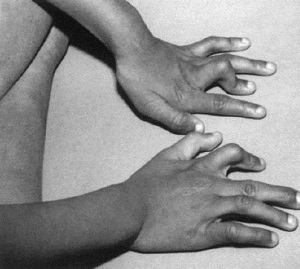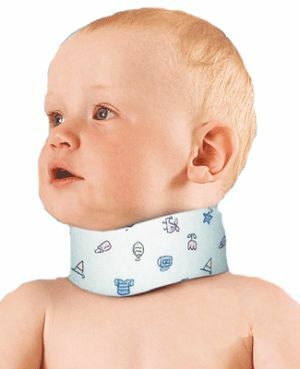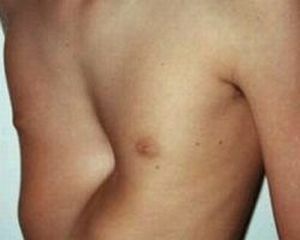 Camptodactyly - a congenital defect caused by a violation of the flexion function of the fingers of the hand from the tendon-muscular apparatus.
Camptodactyly - a congenital defect caused by a violation of the flexion function of the fingers of the hand from the tendon-muscular apparatus.
This means that some fingers, and more often this little finger( in 95%) is in a bent position. Sometimes the second and fourth, or in combination, the 3rd, 4th and 5th fingers of the hand have a limited movement.
The fingers are not in the locked position, they retain a small amplitude of movements( 30-40 °).However, this is not enough for the normal functioning of the hand and the congenital anomaly causes a lot of inconvenience to the person.
In this regard, many seek the help of specialists. But whether they get the expected result depends on how seriously the tendons and muscles responsible for the flexion contracture of the fingers are damaged.
Contents of the article
- The reasons for the anomaly
- How does the abnormal limb look
- Symptoms and complaints of patients
- Diagnosis and treatment of violation
- The real medical case
- Anomaly that results in the consequences of
The causes of the anomaly
The deformed fingers are not an acquired disease. As already noted, with such a defect children are born who inherited an anomaly in a generation.
The experts consider the causes of camptodactyly: 
- the unbalanced work of the flexor and extensor;
- vermicular muscles and tendons responsible for flexion are underdeveloped;
- anatomical abnormality;
- deformed joint;
- inadequate skin.
All this can contribute to the development of a disease of one phalange or several, both on two hands and on one little finger.
How does the abnormal limb look like
? Usually this deviation does not look too ugly, however, on closer examination, it is noticeable that the finger is unnaturally bent, immobile or inactive.
Especially noticeable pathology, if several fingers are struck. In this case, experts speak of a clawed brush.
The pathology looks as though the finger( mostly the little finger) does not unbend itself, and between the proximal phalangeal joints outside it is the coarsened skin. In fact, the finger does not straighten out because of a congenital disease.
Being in this position for many years, it limits the possibilities of the brush and in general, the person.

Symptoms and complaints of patients
When referring to specialists, it is necessary to identify pathology.
Symptoms of congenital disease are:
- metacarpophalangeal joints can not be overtrained;
- with a sample to determine passive extension and flexion, anomaly of vermiform muscles and tendons is revealed;
- lack of tendon connection with the fourth finger.
In the form of a neurogenic contracture, camptodactyly develops after an ulnar nerve injury( paralytic contracture).
Diagnosis and treatment of
disorders Specialists diagnose camptodactyly with:
- congenital snapping finger;
- no extensor;
- arthrogryposis;
- collagenosis.
Determine the pathology after the X-ray examination. The photographs show that there is a groove in the base of the phalanx and a proximal phalanx with a bent, chisel-shaped head.
Treatment of pathology is prescribed only after a thorough examination. When setting the diagnosis, it is recommended that the deformation correction be done exclusively by operative means.
In case of detection of camptodactyly( most often in a child), a specialist who practices a surgeon engaged in brush surgery applies for help. In his practice and work experience there must be methods for correcting the deformities of the hand pathology.
A real medical case
 One of the clinical cases described in the profile literature is encouraging. Operative treatment underwent congenital camptodactyly right hand.
One of the clinical cases described in the profile literature is encouraging. Operative treatment underwent congenital camptodactyly right hand.
Looking at photos of the brush after the operation, post-operative scars are seen on the palmar surface of the fifth finger, becauseplastic was produced by local tissues. The axis of the finger was corrected, also, the flexural position in the proximal interphalangeal joint of the little finger was eliminated.
It was decided to maintain a slight flexion position in the interphalangeal joint for the best brush function. The treatment lasted 7 weeks.
As a rule, before the appointment of treatment, specialists determine the scheme of the operation. At the same time, they warn parents that a hundred percent guarantee of complete cure and success of restoring joint mobility is not there. The operation is adapted to a specific pathology.
Anomaly that entails the consequences of
Complications occur in the practice of treatment of camodontactil. First of all, relapse is possible. This is doubly unpleasant, but doctors always warn about it in advance.
Success is possible and its probability is very high. However, out of 100 operations in one case there is a relapse of development of pathology.
The second complication is skin necrosis, i.e.the death of that part of the tissue that was affected during the operation. Of course, doctors will do everything possible to prevent this from happening, but there is such a possibility.
No less dangerous consequence after surgery can be tendon junctions. When carrying out the operation according to the scheme outlined earlier, doctors try to avoid mistakes, this is why a great deal of experience in conducting profile operations is necessary. Knowing where the danger lies, experienced surgeons easily overcome the threat.

Tendilar adhesions lead to the formation of a clawlike brush
Another invisible enemy of successful surgical treatment is the loss of flexion and stiffness of phalanx after rehabilitation time. In this case, a consultation of the specialized doctor will again be needed, which will determine the cause of the complication and try to minimize its progress.
Camodatacty is not a verdict. Those who decided to correct the pathology, to whom it brings discomfort, it is worth turning to specialists and trying to correct the congenital anomaly.
Moreover, in recent years there are more and more cases of successful and effective surgical treatment. Professionals have long developed treatment regimens, leading to visible results and complete cure.



